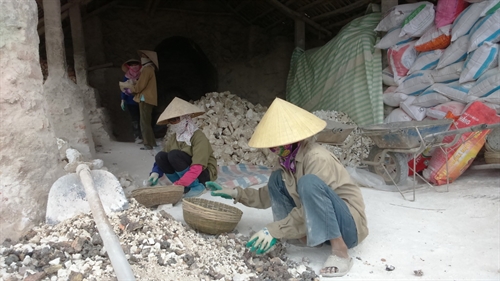

Crushing limestone and building lime kilns is usually considered a man’s job, but dozens of women are performing this work in Đông Tân Commune’s Tân Cộng Village in the northern province of Thanh Hóa.
 |
| Women work at a lime kiln in northern province of Thanh Hóa’s Nông Cống District. — Photo tuoitre.vn |
by Trọng Đức
THANH HÓA — Crushing limestone and building lime kilns is usually considered a man’s job, but dozens of women are performing this work in Đông Tân Commune’s Tân Cộng Village in the northern province of Thanh Hóa.
Working at lime kilns is strenuous, but residents have no choice but to do it to earn a living.
Đắc Thị Hương, 38, a lime kiln owner, said nearly 29 lime kilns in the commune are owned by women.
Women undertake most of the work while men assume the task of transporting lime to other regions for sale.
Hoàng Thị Hoàn, 54, also a lime kiln owner, said that despite their tireless labouring, limestone processing does not yield much profit.
In the past, due to a shortage of cement, people often used lime and sand to make mortar for building. Now, lime is used primarily to improve soil quality and fertility, as well as to pave foundations for houses.
Lime kiln owners earn profits between VNĐ500,000 and 700,000 (US$22.4-31.3) per batch of lime, and it takes about 10 days to produce a batch, Hoàn said. Sometimes, they suffer losses if the lime does not meet qualifications.
“Many times we wanted to quit the job, but we couldn’t,” Hoàn told Khoa Học và đời sống (Science and Life) newspaper. “Lime making has been our traditional trade for generations. We don’t know what else to do to earn a living.”
In addition, the trade can help create jobs for other people as well, she said.
Most employees at lime kilns are poor. The job is dangerous and sometimes comes with blood and tears, but they still do it for survival.
Hồ Thị Lý, another worker from Thanh Hóa Province’s Rừng Thông Township, is 63 years old, but she still works at the kilns.
“I’m the most experienced of the workers at lime kilns in the region,” she said, adding that she has been working at local kilns for the past 30 years.
The salary for a worker has increased from VNĐ1,000 to 120,000 ($5.3) per hour since she started, she said.
“Other women of the same age as me are now enjoying a peaceful life while I spend almost all my spare time working outside. I’ve cried for myself many nights,” Lý said.
Lê Thị Lấn, 55, from Thanh Hóa Province’s Rừng Thông Township, has suffered from health problems after years of hardship, but she still has to work to earn money for her mother and sister, who has a mental illness.
Lấn has applied for less strenuous jobs many times, but has been refused due to her age and fragile health. Eventually, she continued working at lime kilns because the owners knew her situation.
At lime kilns, the women are exposed to heavy environmental pollution caused by dust and emissions. They also face high risks of injury and death due to a lack of compliance with labour safety regulations.
The latest incident occurred in the northern Hải Dương Province. Just four days ago, a lime kiln collapsed, leaving five people dead. The workers were buried underneath the rubble.
Lê Thị Ngọc, a lime kiln worker, said accidents can happen at any time because the workers don’t have enough safety equipment to protect themselves.
In addition, the temperature at lime kilns is sweltering hot, so everyone’s clothes are drenched in sweat all day.
The future for lime kiln workers is uncertain, as local authorities plan to shut down about 200 manual lime kilns in the central Thanh Hóa Province by 2020.
The decision follows a serious accident that occurred in early January at a lime kiln owned by the family of Lê Văn Thong, 56, in Nông Cống District’s Hoàng Giang Commune, causing the deaths of eight people. The accident was later blamed on carbon monoxide poisoning.
Ngô Văn Tuấn, deputy chairman of the provincial People’s Committee, said lime kiln workers will receive assistance to find new jobs.
While waiting for assistance from local authorities, lime kiln workers like Ngọc still dream of being employed by nearby factories one day. -- VNS




